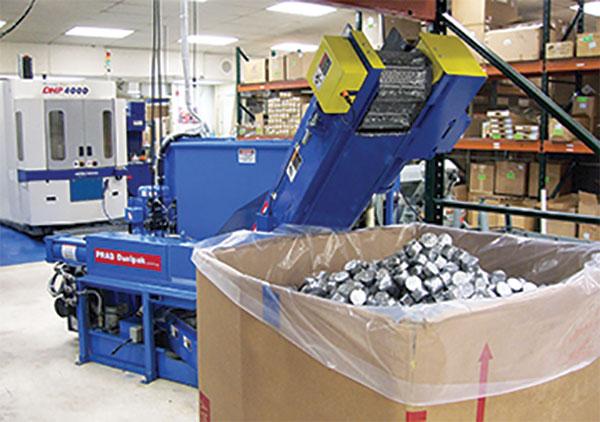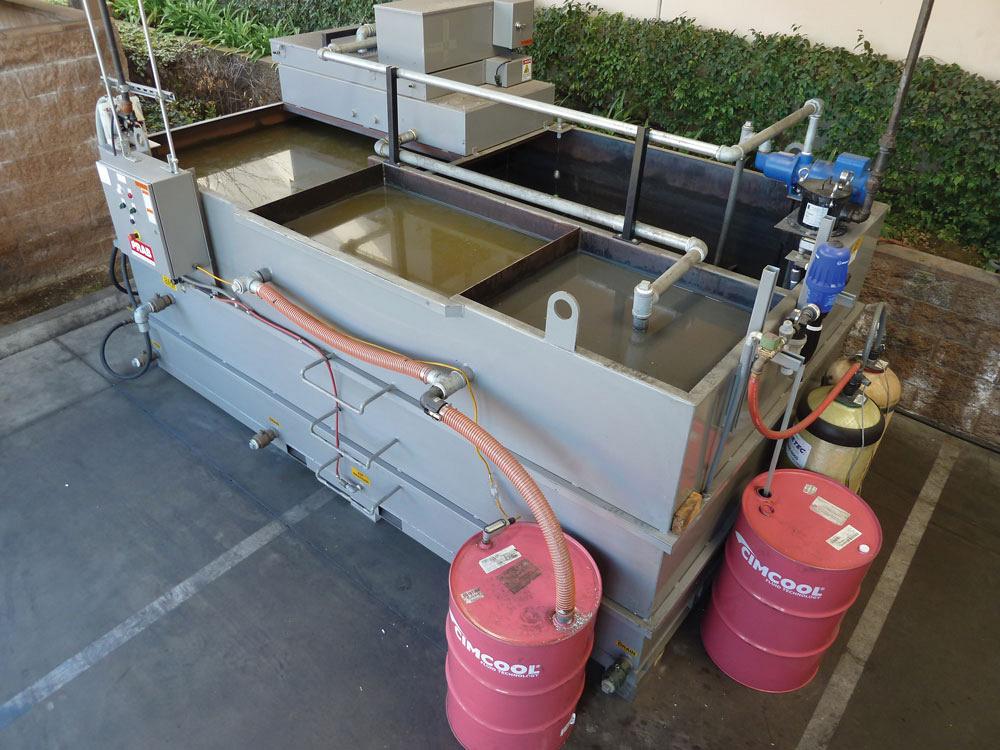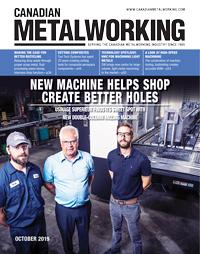Sales and Marketing Director
- FMA
- The Fabricator
- FABTECH
- Canadian Metalworking
Making the case for better recycling
Reducing shop waste through proper scrap metal, fluid processing saves money, improves shop function
- By Mike Hook
- November 6, 2019
- Article
- Metalworking
Waste in Canadian metalworking shops is most commonly represented by a failure to leverage the full value of materials, inefficient use of shift time or production cycles, and avoidable labour. Shops that improve metal scrap and fluid management processes make the most of both time and materials.
There are many areas of a metalworking operation where materials are wasted outright, or shops don’t get the maximum value from materials. However, two materials that often are regarded as unwelcome byproducts of metalworking—metal scrap and spent cutting fluids—actually represent a major source of untapped revenue and savings.
When processed correctly, metal scrap can become a shop’s second-largest source of revenue. The key is to process the metal scrap in a way that increases its value to metal recycling services. Two ways to achieve this are to remove as much excess cutting fluid as possible from the scrap, and to reduce the scrap volume by using automated scrap processing systems.
Centrally located and modular automated chip processing and fluid recycling systems meet the needs of both small shops and large manufacturing operations. These systems’ fluid separation and scrap-reduction capabilities are proven to reduce metal chip moisture content by up to 99 per cent and decrease scrap volume by as much as 90 per cent.
Shops that dramatically reduce the moisture content and volume of their metal scrap will reduce haul-away costs significantly and obtain the highest value from a metal recycler.
Case No. 1
An automotive powertrain manufacturer installed an industrial centrifuge to remove oil from its steel scrap. According to the manufacturer, the liquid/solid separation system enabled the recovery of up to 98 per cent of the oil for recycling or reuse, resulting in a 28 per cent increase in scrap value from its recycler and lower haul-away and disposal costs.
Case No. 2
An aerospace manufacturer added a briquetter, a system that turns loose scrap into solid metal pucks, which earned it 25 cents more per pound for briquetted aluminum pucks. By compressing the loose scrap into pucks that are almost 90 per cent solid, the manufacturer reduced the bulk density of its scrap material significantly. Once boxed, the briquettes were able to fully maximize the 40,000-lb. capacity of the truck used to haul the pucks to the recycler.
Don’t forget fluids
Cutting fluids are another significant source of waste in metalworking operations. Coolant provides lubrication between the workpiece and the tool, which is essential to preventing the cutting tool from overheating.
However, coolant is extremely vulnerable to contamination that, without ongoing intervention, will render it a hazard to tools, parts, and workers. Dirty coolant compromises a shop’s ability to get the full value from its cutting tools, which wear out prematurely when exposed to contaminated coolant.
Contaminated coolant also can damage machining tools, pumps, sumps, and sensitive electronic components. Furthermore, as the coolant breaks down, accuracy and finished-part quality also diminish, which may lower production rates. As a result, many shops dispose of large quantities of spent coolant and buy large quantities of replacement coolant annually.
Coolant sump maintenance is a labour-intensive task. Centralized coolant recycling systems remove tramp oils and suspended solids from contaminated coolant to substantially reduce sump maintenance needs.
Advanced coolant recycling systems can be equipped to continuously monitor coolant concentration and automate concentration adjustments. This not only eliminates manual testing procedures, but it also prevents the inadvertent over-dosing of the system to correct the concentration, which ultimately wastes coolant.
Case No. 3
Koss Aerospace, Mississauga, Ont., was consuming an average of 832 litres of new coolant and disposing of about 4,500 litres of waste fluid every seven to eight days. Koss replaced its basic coalescence system with a centralized fluid recycling system, which reduced its new coolant purchases by 75 per cent and significantly lowered its costs to haul away and dispose of the dirty coolant.
Maximize each shift
Metalworking operations that fail to optimize the potential of each production shift undermine the shop’s ability to yield the maximum throughput. Custom conveying systems have been shown to dramatically improve production efficiencies by overcoming unique on-site application challenges.
Case No. 4
A custom parts manufacturing plant installed custom conveying equipment to reduce downtime. This high-volume plant improved its die change efficiency by more than 50 per cent with a mobile conveyor that cut the time needed to complete a die change from 30 minutes to 12 minutes.
Preventing metal scrap from getting caught in these conveying systems is another way to reduce downtime. Carryover (material that doesn’t discharge from the conveyor) creates maintenance-related downtime. Installing a conveying system that minimizes carryover will help keep production moving.
Reduce manual labour
Many metalworking firms report difficulty finding and retaining qualified employees.
By reducing manual processes, metal shops can reallocate resources to other aspects of the operation. This approach also eliminates strenuous manual tasks, which helps improve overall workplace safety and employee morale.
Using automated scrap processing equipment to minimize manual labour also contributes to more efficient production overall.
Manually transferring metal scrap from the point of production to disposal containers is a routine chore at many Canadian metalworking shops. Automated conveying equipment and load-out systems not only streamline the transportation of metal scrap, they minimize employee involvement. Further, conveyors reduce the need to staff forklift truck operators for the transfer of metal scrap materials.
Because conveyors eliminate one of the most strenuous manual tasks in a metalworking operation and improve workplace safety, they contribute to employee satisfaction and retention while lowering labour-related costs.
Load-out units automate the final load-out of stamping scrap, die scrap, and machining scrap into large trailers or railcars. By nature, these systems eliminate manual processes, but some load-out systems don’t distribute the scrap inside the containers evenly.
Load-out systems designed to optimize container fill, perhaps through extension arms that reach hard-to-fill areas such as corners, will make the most of the container fill space and create efficient haul-away scenarios.
Case No. 5
A metal scrap recycler partnered with its automotive stamping customer to install an orbital load-out system with a swivel chute at the customer’s location. The new system enabled the automotive stamper to increase container capacity from 11,000 kg with its roll-off units to 18,000 kg with the load-out system.
Back-end systems built with the appropriate capabilities for the specific needs of a metalworking operation are shown to reduce waste, create efficiencies, and generate revenue. Addressing immediate scrap processing needs, as well as planning for future needs, will reduce redundant capital expenses in the long term.
Consulting with an experienced metal scrap processing equipment supplier to identify the best automated scrap processing system provides the maximum benefit to the bottom line.
Mike Hook is sales and marketing director for PRAB, 5801 E. N Ave., Kalamazoo, Mich. 49048, 800-968-7722, www.prab.com.
About the Author
subscribe now


Keep up to date with the latest news, events, and technology for all things metal from our pair of monthly magazines written specifically for Canadian manufacturers!
Start Your Free Subscription- Trending Articles
Automating additive manufacturing

CTMA launches another round of Career-Ready program

Collet chuck provides accuracy in small diameter cutting

Sandvik Coromant hosts workforce development event empowering young women in manufacturing

GF Machining Solutions names managing director and head of market region North and Central Americas

- Industry Events
MME Winnipeg
- April 30, 2024
- Winnipeg, ON Canada
CTMA Economic Uncertainty: Helping You Navigate Windsor Seminar
- April 30, 2024
- Windsor, ON Canada
CTMA Economic Uncertainty: Helping You Navigate Kitchener Seminar
- May 2, 2024
- Kitchener, ON Canada
Automate 2024
- May 6 - 9, 2024
- Chicago, IL
ANCA Open House
- May 7 - 8, 2024
- Wixom, MI



















